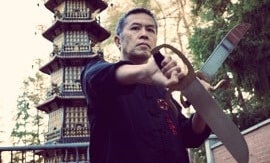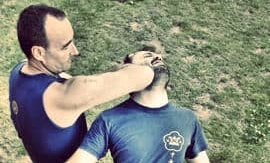
WITH ALL DUE RESPECT TO AYN RAND, WHO WAS JACK DEMPSEY? FRANKLY, IT’S A JEET KUNE DO TRAGEDY THAT MORE OF US DON’T KNOW WHO HE WAS AND, MORE IMPORTANTLY, WHAT IMPACT HE HAD ON THE LITTLE DRAGON AND JEET KUNE DO.
If you watch footage of Lee pulverising the heavy bag in his backyard—beating it like it owed him money—you’ll notice a very distinctive manner in the way he threw his punches. Well, that is after you recover from the shock of seeing a man so small punch harder than many people can kick!
How did he do that? Well, that’s the question. He wasn’t always doing it that way. In fact, after his legendary and very frustrating fight with Wong Jak Man, Lee correctly reasoned that he needed more hitting power. That altercation with Wong, after all, went on for way too long, even though Lee threw something like a gazillion punches. Licking his tactical/ technical wounds afterwards, he knew he needed more power.
And that’s where our man comes in—Jack Dempsey.
First, it’s important to understand that Bruce Lee was both a man of ideas and action. He wanted results and he knew that the best way to get them was to find men that had already got them. So, do you want punching power? Who better to learn from than a fighter they called the “The Manassa Mauler”? Seriously. You don’t get that monicker by slapping like a sissy—especially in the heavyweight division.
So, how good was Dempsey? Well, he was the Heavyweight Champion from 1919-1926. In his career, he won 51 times by KO (records vary because of the shoddy nature of some of his early fights). The thing is, of those 51 KOs, 25 were in the first round. He was a menacing, snarling, two-fisted, panther-quick destruction machine. No less a fighter than Mike Tyson tried to pattern himself after Dempsey.
Dempsey’s title-winning performance against a giant of a man named Jess Willard is instructive as to his incredible offensive capacity. In the first round, after prowling along the rim of the fighting measure, staying outside of Willard’s daunting reach (he was 6′ 6″ and 240lbs!), Jack connected with a thunderous barrage. Willard, who had previously killed a man in a boxing match, was sent to the canvas seven times. Seven. To his credit, he kept getting up only to get hammered back down again. By the end of the round, Willard wasn’t the same man anymore. The soon-to-be former champion had a broken nose. A broken jaw. A broken, smashed orbital bone. He lost hearing in one ear. He had multiple broken ribs and most of his teeth were gone too.
In all, the fallen giant from Kansas appeared to be a casualty of one of the mighty guns from the recently ended World War. No. He was simply the latest victim of the most destructive fighter in Boxing history. Dempsey later said he felt sick to his stomach looking at Willard, appalled at what his inner fury and skill could do to another human being. This was not just any regular fellow, remember, but a man who had beaten Jack Johnson, a champion, and a man who outweighed him by 50 pounds.
Naturally, Dempsey was an instant star and ushered in a new era of sports. No one had ever seen anything like it and even today it’s virtually impossible to understand the heights that Jack scaled in popularity. One story can give us a little perspective, though.
Eddie Sutherland was a powerful Hollywood director in the 1920s. He was convinced that his lover, the famous actress Clara Bow, was having an affair. He told Bow he had to go to New York on some business, to check on some plays that might make good movies. They shared a limo ride to Union Station in Los Angeles, hugging, holding hands, and even weeping as they parted. However, Sutherland got off the train in Pasadena and took a taxi back home. When he went to Bow’s mansion, having a key, he let himself in. The bedroom door was locked. He began knocking and wouldn’t go away as Bow yelled at him to leave or else she’d call the police.
Who calls the police on their lover? She was stalling.
Finally, she opened the door. She was wearing a bathrobe.
“Where is he?”
“Who? It’s just me, Eddie,” she said and tried to usher him out of the room.
“There’s a man here! I smell a man.” “What are you, a bloodhound?”
He looked under the bed. Then he checked the closets. Finally, he came to the bathroom door. It was locked.
“I know you’re in there,” he shouted. “C’mon out here so I can knock your teeth out, you yellow son-of-a-bitch!”
The door opened. There stood Jack Dempsey. Eddie Sutherland had just called Jack Dempsey a coward and threatened to knock out his teeth.
Coming to his senses, Sutherland smiled and apologised. “Jack… I didn’t know it was you. Just kidding, Jack.”
Some reports have Sutherland getting Jack’s autograph before he left. Imagine that. Imagine finding a man in bed with your girl and you get his autograph… and then you tell all your friends. That’s how famous Dempsey was, and that fame was built upon those fists.
Alas, Dempsey wasn’t that famous because he was a wild animal in the ring. Far from it. As alluded to in his book Championship Fighting: Explosive Punching and Aggressive Defense, of which Lee was a serious student, Jack was a highly scientific puncher who knew how to get every last bit of payload into every punch. Jack didn’t believe in light punches as set-ups—that’s what fakes were for! No. He went all-in on every shot and from him, Lee learned what became essentials in the Jeet Kune Do system: the power-line, falling-step straight punch, and the four ways to get maximum power in every punch. To watch Bruce hammer the heavy bag is to see a Dempsey student.
There was a key in Dempsey’s approach that coincided with the Wing Chun Lee already knew. Jack, unlike other boxers, threw his straight jab (which he called “The Jolt”) with a vertical fist. This allowed Lee to rather seamlessly integrate the new skills into his already existing framework.
Jack taught readers in his book how to throw The Jolt with a step, hand before foot. Most people mistakenly believe that Jeet Kune Do’s non-telegraphic structure comes from fencing only. However, there’s an enormous difference between striking someone with a blade and punching them. Dempsey provided the structure to punch with balance and power without telegraphing, thereby revolutionising Bruce Lee’s game.
After the Stepping Jolt (the Falling Step), Dempsey taught us that power punching came from not just springing forward (off the back foot) and falling forward (the gravity assist you get from the explosive step provided your punch lands before your front foot hits the floor) but also from upward surge and shoulder whirl. He said that in punching, the fist gets all the glory but it’s really only along for the ride. Every blow should have maximum body structure behind it. Bomb them, he said! And so he did, and so did Bruce after him.
The fact that Jack Dempsey isn’t known as a primary source of Jeet Kune Do is, as I said, a regrettable tragedy, as it relegates students to trying to reinvent the wheel. People say, “Man, Bruce could hit harder than anyone his size—he hit like a heavyweight.” They say this as though Lee was superhuman. No. He was a student of Dempsey, and you can be too. That’s where it started.
So, who was Jack Dempsey? The most fearsome puncher in Boxing history and, believe it or not, one of the foundations upon which Jeet Kune Do was built.



















